Studies show that the primary source of company feedback comes from managers and also a particular group of non-managers who employees believe can provide meaningful feedback.
Why is feedback important?
Managers play a key role in fostering a productive, inclusive, and strong culture. They are responsible for recruiting and retaining talent, engaging employees, developing teams, and setting performance goals. One of the most important roles of managers, often overlooked, is the role of providing feedback. Feedback is essential for employees and is necessary to engage and activate talent.
Giving feedback helps promote employee development but can be overwhelming for managers. At Happily.ai, we facilitate Peer Feedback as an alternative to traditional performance reviews. We provide opportunities for employees to voluntarily ask for feedback from anyone in the organization. Those who are requested to provide feedback can choose whether or not to accept the request.
Making feedback voluntary is shown to help employees practice self-improvement, be less resistant to receiving critical feedback, and be more sustainable in increasing performance. In this study, we analyze the people who are sought out for feedback by analyzing data from 3,983 peer feedback interactions in Happily, an engagement platform.
Study & Results
Our Hypothesis: “People who are asked to provide peer feedback are more likely to be managers.”
Our Study
We collect data from two companies: Company A with 27 managers and 124 non-managers, and Company B with 27 managers and 363 non-managers. The number of voluntary peer feedback requests initiated by each person is analyzed. There are a maximum of 2 requests that can be made by each employee per month.
The manager to employee relationship is a byproduct of organizational design. Other types of relationships can be formed outside of these constructs. Relational analytics, from peer recognition data, is used to classify talent based on the recognition given from formal and informal networks developed from people working together.
Peer recognition provides a measure of Network Effectiveness — how much a person contributes to the people around them (informal). Manager recognition offers a measurement of individual performance evaluated by a person’s manager (formal).
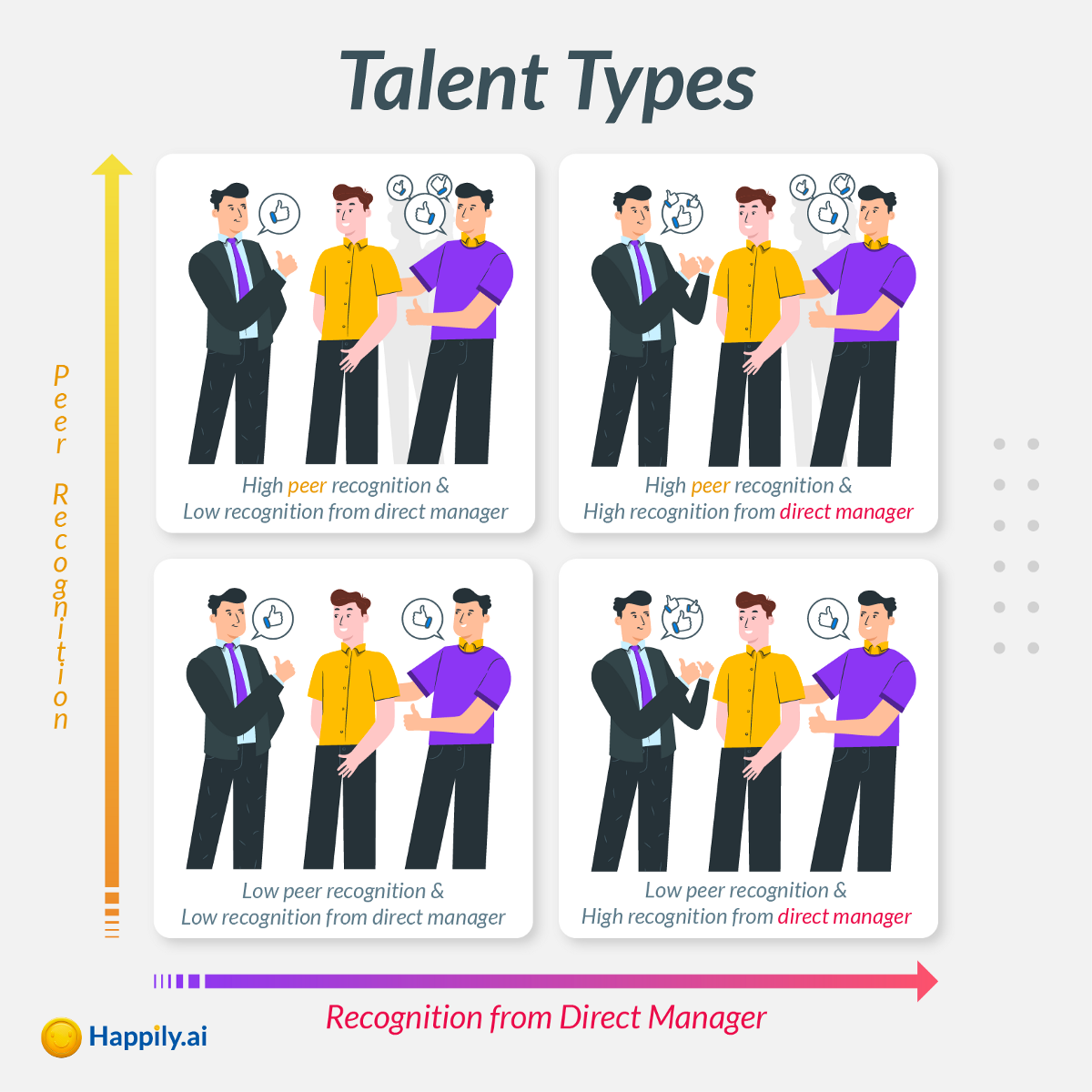
Four classifications, or groups, are created based on recognition characteristics:
- Group 1: Low Network Effectiveness and Low Individual Performance
- Group 2: Low Network Effectiveness but High Individual Performance
- Group 3: High Network Effectiveness but Low Individual Performance
- Group 4: High Network Effectiveness and High Individual Performance
Talent in Group 4, with high peer recognition and recognition from their direct manager, are considered top performers. They excel at individual performance and actively contribute to those around them.
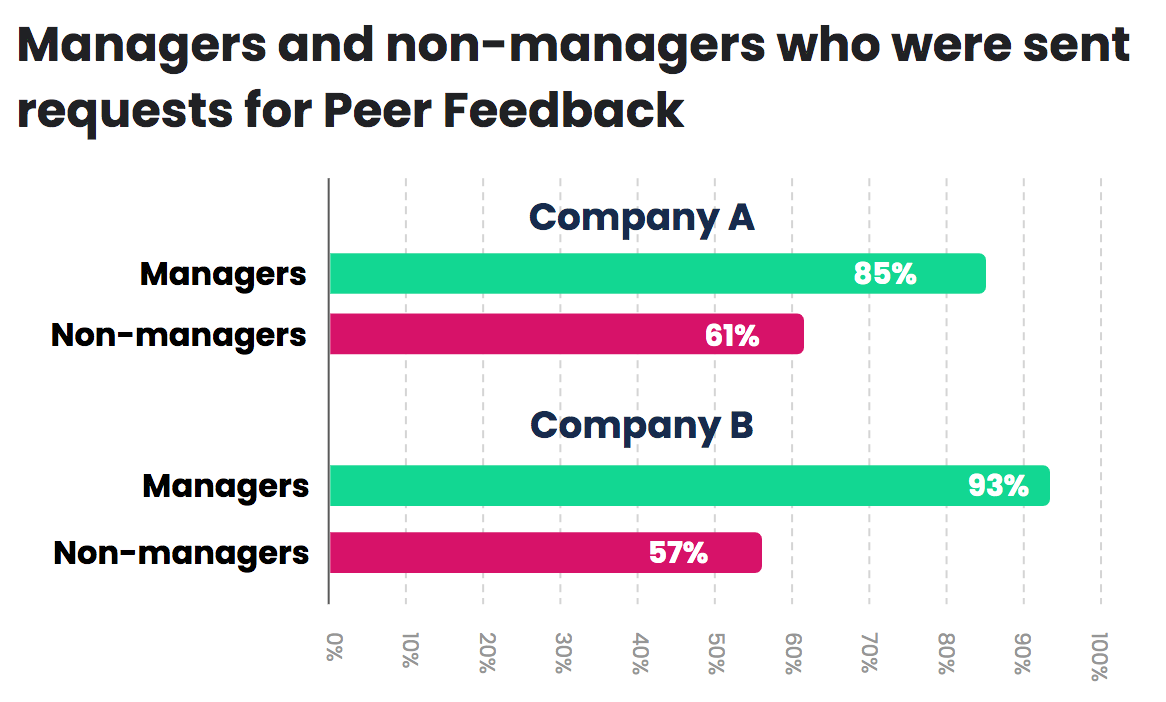
Interaction data show 66% of Company A employees and 59% of Company B employees were sent requests for Peer Feedback. We consider two groups: managers and non-managers. There are 85% of Company A managers, and 93% of Company B managers were sought out for feedback. In comparison, 61% and 57% of non-managers were sought out for feedback in Company A and Company B, respectively.
It is evident that the vast majority of managers are selected to provide feedback. Employees seek feedback from their own managers or other managers because they represent figures of credibility and experience in a role that is typically associated with evaluating the performance of others. However, more than half of the non-manager in both companies were also requested for feedback. The significant amount of peer feedback interactions shows that employees are eager and in need of feedback to improve themselves and understand what is expected of them.
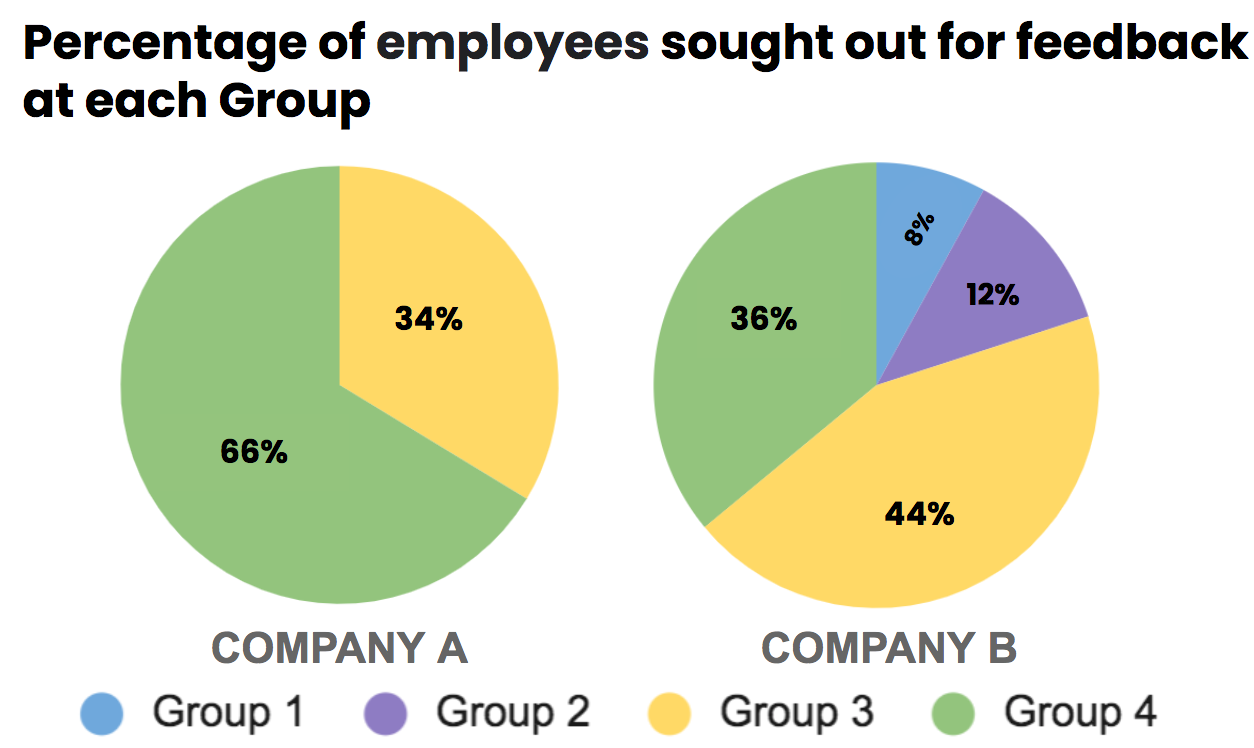
Further study finds that managers and non-managers sought out for feedback are mostly in Group 3 and Group 4, the talent classification representing high network effectiveness. This suggests that the source of feedback is not limited to managers, but expands to others in the organization who are high contributors in other areas. In a previous study, Group 3 and Group 4 represent talent with high network effectiveness, suggesting that employees who receive recognition are more likely to contribute meaningful feedback.
Four tips to give effective feedback
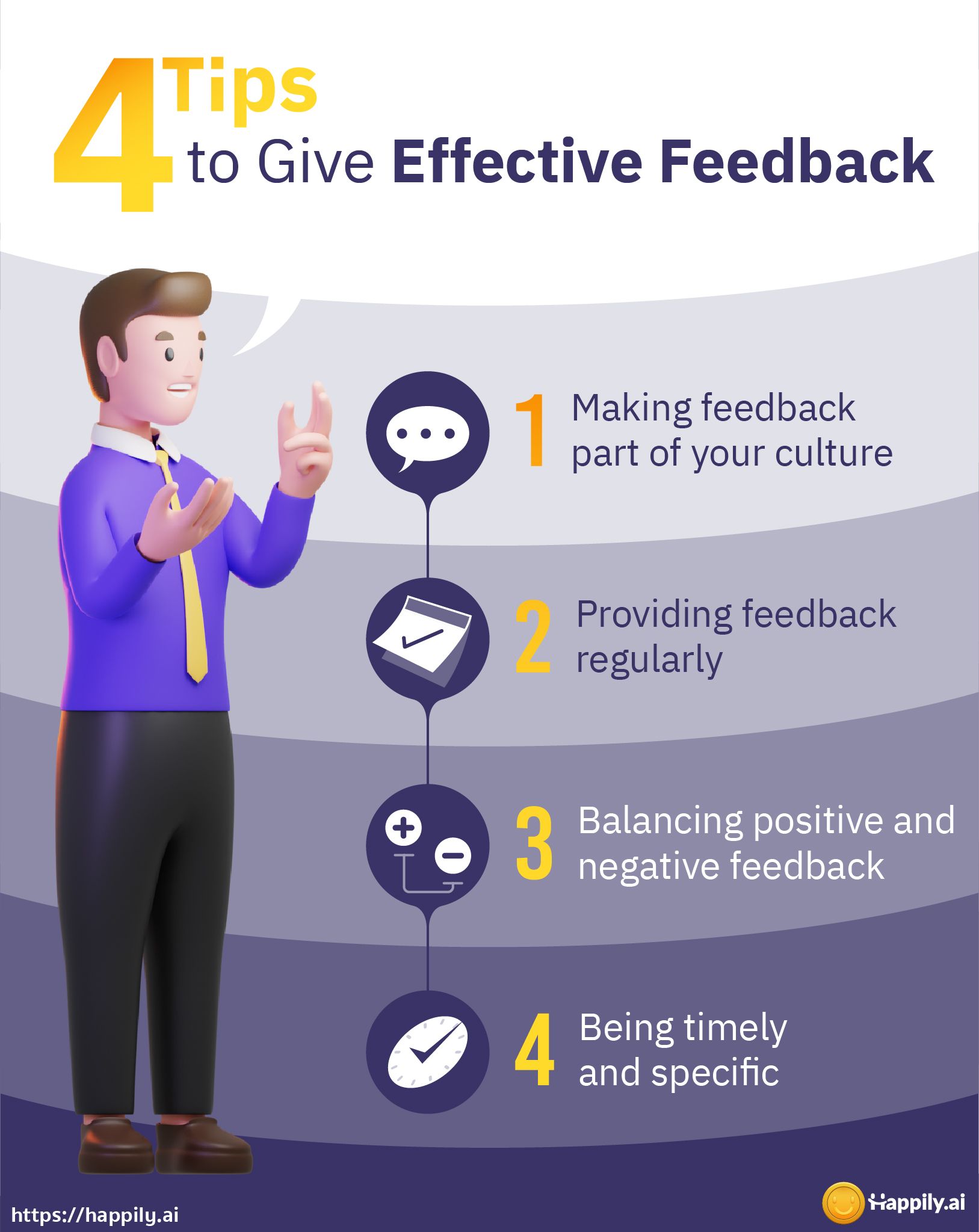
Effective feedback is a powerful tool to engage and develop your team. Leaders and managers can make sure feedback is valuable and meaningful by:
1. Making feedback part of your culture
Too often, feedback is seen as a negative interaction. Managers should establish a clear and shared understanding that feedback is a positive part of learning, growing, and working together. Managers should lead by example, asking for feedback from team members. If your employees understand the difference between critical and negative feedback, they are in a better position to accept it and put your suggestions to use. Managers can use feedback as an alignment mechanism, making employees aware of what’s working and what should be adjusted.
2. Providing feedback regularly
Providing regular feedback helps employees see feedback as a normal part of the everyday conversation rather than a special event. Employees can then expect and be ready for what’s coming up and will not be afraid of asking for feedback. Providing feedback in a timely way guides employees in a way that is productive to them (personal and career growth) and the organization (company alignment).
3. Balancing positive and negative feedback
When providing feedback, managers should make sure to balance between the positive and the negative. Pointing out only weaknesses will not help your employees improve. Managers can increase engagement and team productivity by helping employees develop strengths and making them see how their strengths can work for or against them. When giving critical feedback, point out some positives in the employee’s attitude or effort. When providing positive feedback, give the employee some things to work on to help them feel like they still have room to grow. However, be careful not to "sandwich" your feedback by providing both positive and negative feedback at the same time.
4. Being timely and specific
Managers should be timely and specific when providing feedback. Telling employees that their work needs improvement without giving details can be counterproductive. Being specific, with examples, helps employees understand what to keep doing, and what to change. Managers should not let days or weeks pass by before giving employees feedback. Feedback is most relevant and actionable when it’s provided at the right time. Saving feedback for later so that you have something to write about in an upcoming performance evaluation is the wrong approach.
Conclusion
Giving regular, specific, and constructive feedback is an effective tool for managers seeking to improve team engagement, productivity, and growth. It is not a surprise that employees ask for feedback from people who are managers —those seen as the more experienced, credible, and competent. However, non-managers who have high network effectiveness are also a prominent source of feedback. It is clear that employees value the feedback that is constructive, well-intentioned, and meaningful.
Although managers are not the only source of feedback in the organization, they still play the primary role in cultivating a feedback culture. At Happily.ai, we help facilitate a culture of feedback with an alternative to the outdated performance review. Happily’s Peer Feedback makes feedback less overwhelming for both managers and teams. Feedback is voluntary, those giving feedback can be confident that their feedback is valued. And those seeking feedback can trust that the feedback received is meaningful and well-intended. To learn more about employee feedback platform and strategies, we invite you to check us out at Happily.ai.
Happily.ai is an all-in-one employee experience platform that fosters a resilient workplace. Organizations use Happily to run daily check-ins, enable better feedback and conversations, and develop people managers. Real-time insights are available to help you better understand your teams and people. Visit us on our website or sign up for a demo here!
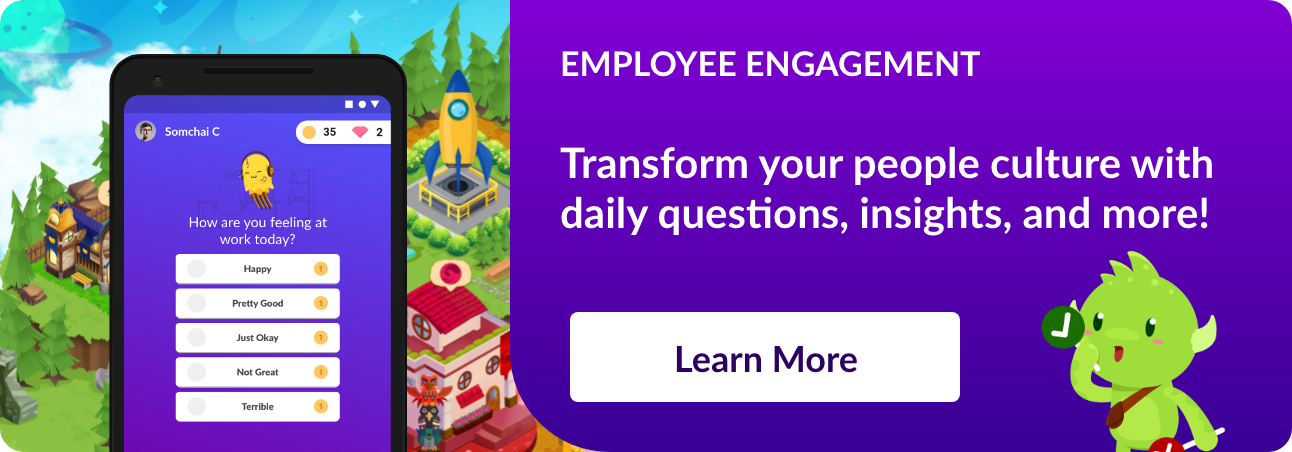
References:
[2] https://magazine.wharton.upenn.edu/digital/a-managers-guide-to-giving-feedback/
[4] https://online.champlain.edu/blog/giving-constructive-feedback










